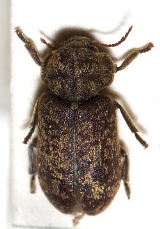
Death watch beetle
Encyclopedia
The death watch beetle, Xestobium rufovillosum, is a woodboring beetle
. The adult beetle
is 7 millimetre (0.275590551181102 in) long, while the xylophagous larva
e are up to 11 mm (0.433070866141732 in) long.
To attract mates, these woodborers create a tapping or ticking sound that can be heard in the rafter
s of old buildings on quiet summer nights. They are therefore associated with quiet, sleepless nights and are named for the vigil
(watch) kept beside the dying or dead, and by extension the superstitious have seen the death watch as an omen of impending death.
The term "death watch" has been applied to a variety of other ticking insects including Anobium striatum
, some of the so-called booklice of the family Psocidae
, and the appropriately named Atropos divinatoria and Clothilla pulsatoria.
The larva is very soft, yet can bore its way through wood, which it is able to digest using a number of enzymes in its alimentary canal provided that the wood has experienced prior fungal decay.
Woodboring beetle
The term woodboring beetle encompasses many species and families of beetles whose larval or adult forms eat and destroy wood . Larval stages of some are commonly known as woodworms.-Invasion and control:...
. The adult beetle
Beetle
Coleoptera is an order of insects commonly called beetles. The word "coleoptera" is from the Greek , koleos, "sheath"; and , pteron, "wing", thus "sheathed wing". Coleoptera contains more species than any other order, constituting almost 25% of all known life-forms...
is 7 millimetre (0.275590551181102 in) long, while the xylophagous larva
Larva
A larva is a distinct juvenile form many animals undergo before metamorphosis into adults. Animals with indirect development such as insects, amphibians, or cnidarians typically have a larval phase of their life cycle...
e are up to 11 mm (0.433070866141732 in) long.
To attract mates, these woodborers create a tapping or ticking sound that can be heard in the rafter
Rafter
A rafter is one of a series of sloped structural members , that extend from the ridge or hip to the downslope perimeter or eave, designed to support the roof deck and its associated loads.-Design:...
s of old buildings on quiet summer nights. They are therefore associated with quiet, sleepless nights and are named for the vigil
Vigil
A vigil is a period of purposeful sleeplessness, an occasion for devotional watching, or an observance...
(watch) kept beside the dying or dead, and by extension the superstitious have seen the death watch as an omen of impending death.
The term "death watch" has been applied to a variety of other ticking insects including Anobium striatum
Anobium striatum
Anobium striatum is a species of beetles in the genus Anobium of the family Anobiidae....
, some of the so-called booklice of the family Psocidae
Psocidae
Psocidae is a family of Psocoptera belonging to the suborder Psocetae. Member of the family are easily recognised by their wing-venation, where the areola postica is fused to the M-vein, giving rise to the so-called discoidal cell. This family is closely related to Myopsocidae.-Sources:*Lienhard,...
, and the appropriately named Atropos divinatoria and Clothilla pulsatoria.
The larva is very soft, yet can bore its way through wood, which it is able to digest using a number of enzymes in its alimentary canal provided that the wood has experienced prior fungal decay.

